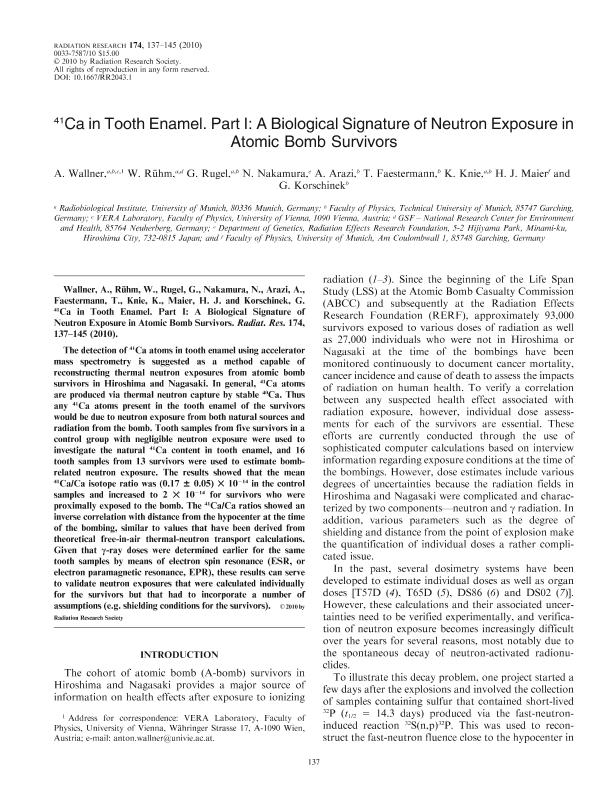Artículo
41Ca in tooth enamel. part I: A biological signature of neutron exposure in atomic bomb survivors
Wallner, A.; Ruhm, W.; Rugel, G.; Nakamura, N.; Arazi, Andres ; Faestermann, T.; Knie, K.; Maier, H. J.; Korschinek, G.
; Faestermann, T.; Knie, K.; Maier, H. J.; Korschinek, G.
 ; Faestermann, T.; Knie, K.; Maier, H. J.; Korschinek, G.
; Faestermann, T.; Knie, K.; Maier, H. J.; Korschinek, G.
Fecha de publicación:
08/2010
Editorial:
BioOne
Revista:
Radiation Research
ISSN:
0033-7587
Idioma:
Inglés
Tipo de recurso:
Artículo publicado
Clasificación temática:
Resumen
The detection of 41Ca atoms in tooth enamel using accelerator mass spectrometry is suggested as a method capable of reconstructing thermal neutron exposures from atomic bomb survivors in Hiroshima and Nagasaki. In general, 41Ca atoms are produced via thermal neutron capture by stable 40Ca. Thus any 41Ca atoms present in the tooth enamel of the survivors would be due to neutron exposure from both natural sources and radiation from the bomb. Tooth samples from five survivors in a control group with negligible neutron exposure were used to investigate the natural 41Ca content in tooth enamel, and 16 tooth samples from 13 survivors were used to estimate bomb-related neutron exposure. The results showed that the mean 41Ca/Ca isotope ratio was (0.17 ± 0.05) × 10-14 in the control samples and increased to 2 × 10-14 for survivors who were proximally exposed to the bomb. The 41Ca/Ca ratios showed an inverse correlation with distance from the hypocenter at the time of the bombing, similar to values that have been derived from theoretical free-in-air thermal-neutron transport calculations. Given that γ-ray doses were determined earlier for the same tooth samples by means of electron spin resonance (ESR, or electron paramagnetic resonance, EPR), these results can serve to validate neutron exposures that were calculated individually for the survivors but that had to incorporate a number of assumptions (e.g. shielding conditions for the survivors).
Palabras clave:
-
Archivos asociados
Licencia
Identificadores
Colecciones
Articulos(SEDE CENTRAL)
Articulos de SEDE CENTRAL
Articulos de SEDE CENTRAL
Citación
Wallner, A.; Ruhm, W.; Rugel, G.; Nakamura, N.; Arazi, Andres; et al.; 41Ca in tooth enamel. part I: A biological signature of neutron exposure in atomic bomb survivors; BioOne; Radiation Research; 174; 2; 8-2010; 137-145
Compartir
Altmétricas



